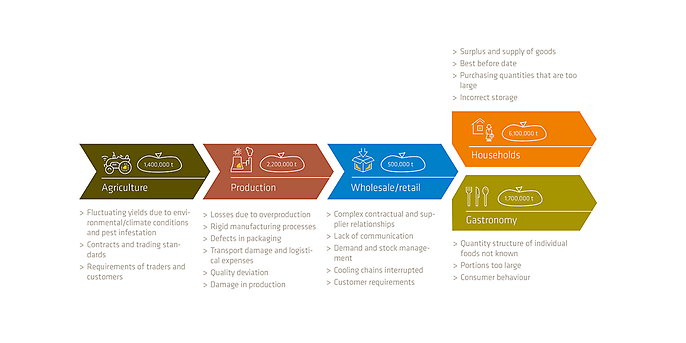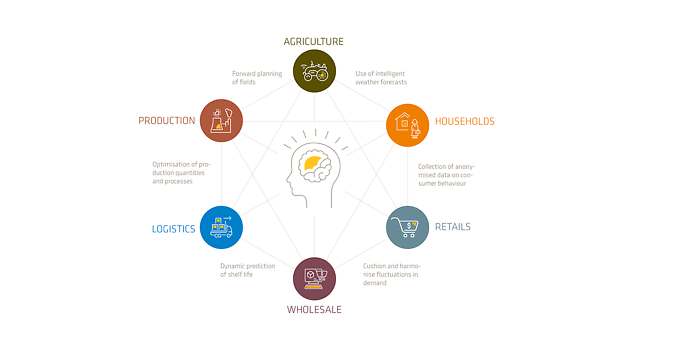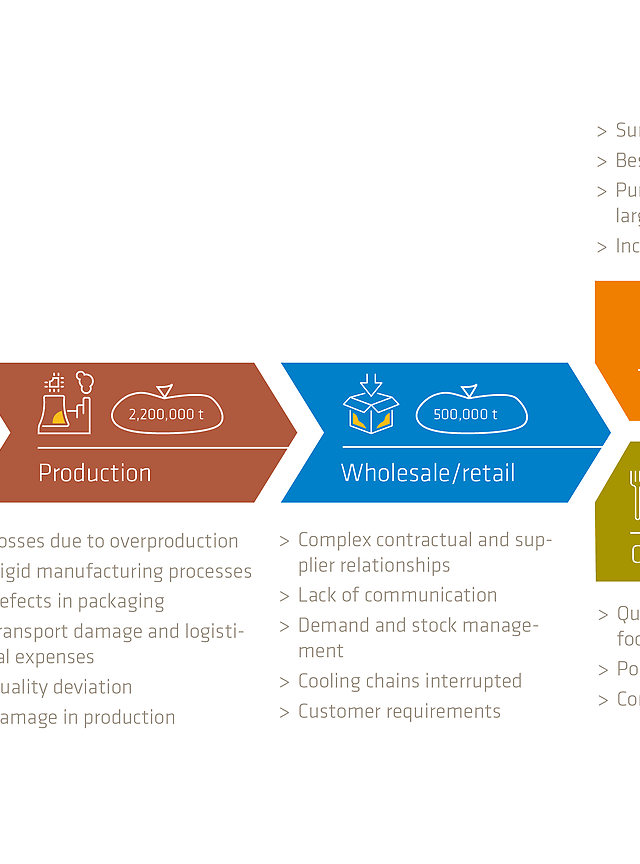8. June 2021 By Alexander Wiermann
Opportunities provided by digitalisation for promoting food sustainability
When choosing our food, it has become increasingly important to us that it is rich in nutrients, full of vitamins and healthy. We also want the origin and ingredients used to be made transparent. If these ingredients also come from farmers in the region, we are prepared to accept a sales price that is above the market average. When shopping in a supermarket, it does not take long for us to realise that there is a huge surplus supply of food. The shelves are full of product variations for which there are only rarely any supply bottlenecks. Even if we do our shopping late at night, there is still a full range of products to choose from. How is it possible to constantly offer fresh food and a wide range of products? This is only made possible by stocking large quantities and maintaining good supply chains. For us as consumers, this is a luxury, but it also comes at a price.
A large amount of food is not consumed. Instead, packages of food fall prey to the landfill site. In its food and agriculture report, the United Nations (FAO) speaks of 1.3 billion tonnes of wasted food worldwide that ends up in the rubbish. In contrast, 800 million people around the world are starving. The Federal Ministry of Food and Agriculture (BMEL) estimates food losses at 12 million tonnes in Germany. Studies have uncovered the fundamental problem, although there are gaps in data in the collected information and surveys along the value chain. We are wasting a lot of food at the same time as the global demand for food is growing due to an increasing world population of about 82 million people per year (Statista).

Simplified illustration of the value chain of our food and examples of types of waste. Source: own illustration; Federal Ministry of Food and Agriculture
Food waste has a significant impact on the environment, such as increased water consumption, unnecessary generation of CO2 as well as economic follow-up costs for businesses (BMEL).
The reasons for the problems lie in the value and supply chains that are a highly complex network involving numerous actors. Crucial reasons for the waste of food include the different – also not digitalised – production processes, strong and unpredictable fluctuations in demand (bullwhip principle), challenging plannability for agriculture and the high demands of consumers in terms of quality.
Artificial intelligence and digital services are on the rise, but...
Advancing digitalisation and the use of artificial intelligence (AI) make it possible to counteract the challenges mentioned and improve sustainability. This applies, in particular, to the use of key findings from large amounts of data provided by value-added processes. As a result, digitalisation influences the basic starting points, models and methods and, at the same time, enables new opportunities for the food industry. In terms of the degree of digitalisation, retail, logistics and industry have advanced within their own domain thanks to individual autonomous solutions. Here are a few examples:
- Market and staff planning through various empirical values and key figures
- Intelligent evaluation of purchasing behaviour and automated fraud detection
- Dynamic price adjustments (topic for discussion)
- Optimised route planning based on production and transport volume
- Adapted product and resource planning
- Digitalised quality management, process optimisation and control
However, it is not only necessary to digitalise the individual sections of the value creation stages. In the food industry, there are no standard interfaces for networking solutions. There is a lack of cohesion and holistic production chain approach involving all stakeholders. The rule here is: Everyone must pull together! An organisational, economic and technical AI ecosystem is needed to exploit synergies.
Thinking one step ahead with networked artificial intelligence
The use of an intelligent learning network of the food value chain and the provision of data from upstream and downstream processes can help to solve the problem. The REIF (Resource-Efficient, Economic and Intelligent Foodchain) project, consisting of science and companies, brings everyone together. Taking into account governance, data availability, data protection, integration of standardised guidelines and incorporation of legislation, all information from the sectors flows into a central platform. The collected data from the companies involved and AI methods implemented contribute to the elimination of control problems throughout the entire process cycle.

Networked artificial intelligence and use of information from the entire value chain. Source: own illustration; REIF project
The goal is to reduce food waste by at least 50 per cent and avoid overproduction by the year 2030. The networked solution includes a holistic approach with two important fields of action:
- Improving the plannability of production stages and increasing the quality of processes by means of artificial intelligence
- Optimisation of value chains and simplified communication between companies on one platform to increase resource efficiency
Consumer demand can be predicted with the help of the network’s improved data and information exchange. At the same time, manufacturing companies can make adjustments to production planning and procedures in order to react to fluctuations in demand at an early stage. At the same time, this promotes more demand-oriented production processes and loss-reducing sales strategies. The entire supply chain benefits from the exchange of information, for example, supermarkets can sell more meat and barbecue food on days with nice weather and can adjust demand from the retailer to the slaughterhouse. Conversely, order quantities are reduced and the consumer benefits from timely discounts when there is bad weather (Fraunhofer).
Summary and conclusion
Digital solutions that support sustainability along our food supply chain are already firmly anchored in the individual sectors. A holistic approach to valuable data and information sharing from production and trade levels offers a high degree of utilisation from agriculture to the consumer. Intelligent systems track food on its way from the field to the sale of the goods and evaluate the consumer behaviour of the past years. Reliable forecasting of fluctuating demand is the key to solving the problem of overproduction and oversaturation of the markets.
Would you like to learn more about exciting topics from the world of adesso? Then take a look at our artificial intelligence page.


